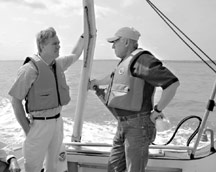 |
||||||||
|
Volume 12, Issue 25 ~ June 17-23, 2004
|
||||||||
|
|
Dock of the Bay Wading In to Clean up the Bay It wasn’t Wade-In-as-usual this 17th year on the Patuxent.
Former Democratic state senator Fowler’s podium featured a huge photo of Republican Ronald Reagan. Sen. Barbara Mikulski arrived dressed in red, including bright red rubber boots. Reaching across old party hostilities was clearly the leading theme. “I’m here to make a Bay statement, not a fashion statement,” Mikulski insisted. “The Chesapeake Bay does not belong to a political party; it belongs to all of us.” The senator then led off the chorus of commendations to Gov. Robert Ehrlich for the Bay-cleaning flush tax proposed by his administration and passed by the General Assembly this year. Republicans and Democrats alike lauded both former Gov. Harry Hughes and Bernie Fowler, icons for this river group. Democratic Congressman Steny Hoyer promised T-Shirts with the legend Fowler’s Followers. Calvert Commissioner David Hale and St. Mary’s Commissioner Tom McKay, both Republicans, presented Fowler with formal statements promising continued care for the river. Even the nonpartisan and pessimistic Chesapeake Bay Foundation predicted better times ahead. “2004 will be seen as the tipping point at which we started to see improvement in the Chesapeake Bay,” said Foundation President Will Baker.
“I was in elementary school,” said Ehrlich, when Hughes started his Bay work in 1979. “So listen to your elders!” intoned a voice from the audience. Ehrlich answered that admonition with his promise to “clean up the river and Bay — not just maintain the status quo.” Fowler’s call for tangible cleanup commitments drew plenty of general affirmations of concern but few specific promises.
Instead of specific commitments, Mikulski brought humor to the overcast day. “A waterman would never wear those,” Maryland Sen. Roy Dyson said of her red boots.
Q If I get ladybugs for my garden, how should I release them? Ten Million Oysters Find Sanctuary in the Patuxent At former state Sen. Bernie Fowler’s Annual Wade-In June 13, U.S. Rep. Steny Hoyer pledged to help plant 350,000 baby oysters in the Patuxent River.
“If we continue our efforts, good things are going to happen,” said Hoyer of the oyster restoration project. These oysters come from Horn Point Laboratory, part of the University of Maryland Environmental Science Center in Cambridge, which hatches many of the Bay’s restored oysters. By summer’s end, 10 million new oysters will live in the Patuxent River sanctuary. The sanctuary is as new as these young bivalves. The nearly six acres of oyster sanctuary off Trent Hall in St. Mary’s County arose from the messy spill at the Chalk Point Power Plant that coated the river with some 140,000 gallons of oil four years ago. The spill oiled some 80 acres of wetlands and shoreline, killing more than 1,000 birds and animals, including waterfowl, diamondback terrapins and muskrats. The spill also harmed finfish and shellfish and hampered roughly 125,000 river trips by fishermen and recreational boaters. Thus it ruffled feathers of ruddy ducks and humans alike. “The community was worried about the status of shellfish, wildlife and the environment,” said Hoyer, who lives near the site of the oil spill and new sanctuary. From the first hours, cleanup crews worked to contain and restore the damage from the Pepco Plant spill. Three trustees — the state, U.S. Fish and Wildlife and the Damage Assessment and Restoration Program of the National Oceanic and Atmospheric Administration — oversaw the utility during the years of the cleanup. Oysters were the focus this morning, but other restoration projects dot the Patuxent River map. Six acres of intertidal marsh wetland will be created; beach habitat and shoreline will be restored; and ruddy duck nesting habitat will be recovered. Restoration can’t turn back the clock, but it’s trying to make up for lost time. Having calculated how many recreational trips were lost, state and federal restoration agencies will build two paddle-in campsites on the Patuxent River plus boat access points and a disabled-accessible kayak/canoe launch. “The Patuxent is a unique river in Maryland,” said Hoyer, “We believe this can be an extraordinary example of what we can do.” —Carrie Steele In Virginia, you can get legally baptized now in the Rappahannock River if that’s your thing. Bowing to pressure from an odd alliance between the American Civil Liberties Union and the Christian Defense Coalition, the Fredericksburg-Stafford Park Authority reversed itself and ruled that clergy at the Cornerstone Baptist Church could dunk parishioners in search of salvation… In Hong Kong, they finally captured the elusive crocodile whose meanderings we followed as he embarrassed the world’s most famous crocodile hunters. Five-foot-long Croc Croc Chan quietly swam into a fisheries department trap last week, ending a seven-month saga followed around the world. The famous reptile will live out its life at a park — unless it escapes… Our Creature Feature comes from British Columbia, where a lonely killer whale who has been searching for companionship along Canada’s Pacific Coast for three years will be captured next week and placed with the pod that may have kicked him out. |
|||||||
|
© COPYRIGHT 2004 by New Bay Enterprises, Inc. All rights reserved. |





